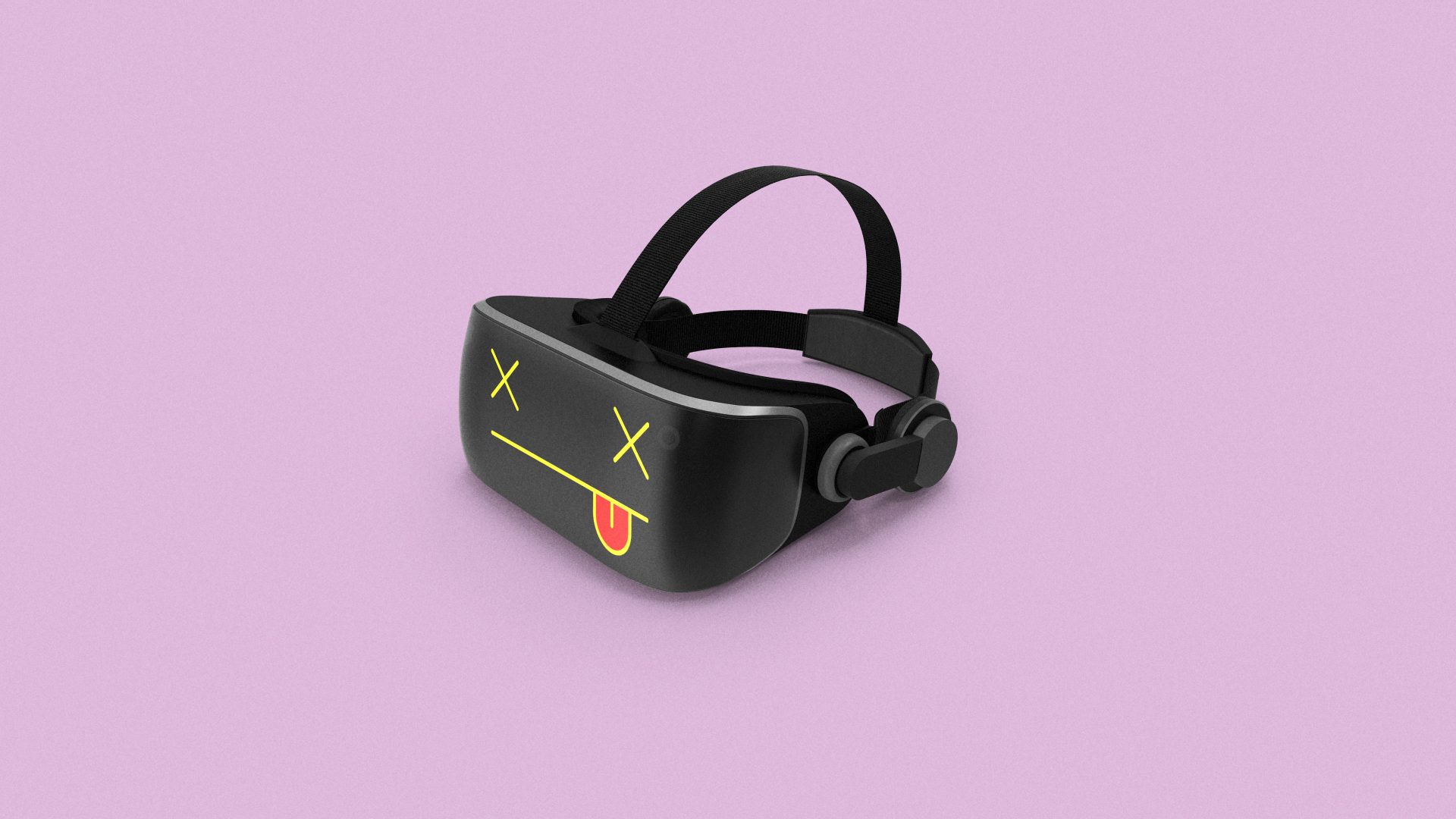This was supposed to be a simple assignment: a state-of-the-nation-type piece looking at one of the world’s biggest companies – Meta, the company once known as Facebook.
Mark Zuckerberg, the last of the big four tech founders to still run his own company full-time, is taking advantage of his controlling shareholding to make a huge, generational bet on the future of the company.
He has pledged to spend $100bn (£83bn) – yes, billions with a b, not millions – over the next decade to make his company (now renamed Meta to show its new focus) the winner of the next generation of the internet.
So, when the New European’s commissioning editor, Jay Elwes, suggested I look at this as a topic, and look at how the bet is going, with around $20bn spent since Zuckerberg’s new focus, I was happy to take on the assignment. I didn’t even notice the danger therein, the simple and seemingly innocuous next sentence – “go for a wander round” and “see what it’s like”.
Little did I know that this supposedly straightforward endeavour would sap what little of my sanity was left – after the last few years of just, well, living in the world – lead to physical injury, a fight with a (real-world) cat, and a full-scale existential crisis in a virtual reality lavatory.
But all of that was still in my future. Before we get ahead of ourselves, it is worth taking a moment to think about what “the metaverse” actually is. As with many concepts in big tech, people completely disagree on what is or isn’t a metaverse, and on the extent to which it is puffed up by hype.
The general concept is of a liveable online space – usually understood to rely on virtual reality (VR) – that joins up lots of different worlds and activities. Where at present you might use one program to browse the net, check your bank on a different app, and then use a third altogether to play a game, in the metaverse you could at least notionally do all of these things in one continuous experience.
The reality at present falls considerably short of that, but Meta bought up a leading VR headset manufacturer, Oculus, as early as 2014 – suggesting this isn’t a new hyperfocus for Zuckerberg – and has maintained a team updating its VR headsets ever since.
It has some hardcore headsets for gamers, which have to be combined with high-end PCs, but its lead consumer model is the Quest 2, which can be used without a computer, and which allows you to enter Horizon Worlds, Meta’s flagship metaverse product.
Horizon Worlds, Meta promises, offers a “virtual universe with thousands of experiences for you to explore”. That ranges from places where you can play games, socialise, watch live comedy, or watch gigs from stars including John Legend and Billie Eilish. The idea is also that, à la Minecraft or Roblox, you can then also build your own “worlds” within Horizon’s universe, which other users can then visit.
After numerous efforts to beg, borrow, or steal a Quest 2 headset, I bite the bullet and spend £399 at Meta’s UK store, just to write this column (don’t say I never do anything for you, dear reader).
At first, everything looks good. The Quest 2 arrives in a very fancy box, and the thing itself – a white headset with elasticated bands to secure it to your head, plus two quite snazzy controllers for your hands, seems to have really good build quality. Maybe this will be… good?
My first physical experience of the Quest 2 quickly disabuses me of that idea. As soon as I try to put on the headset (after much fiddling with straps to try to make them loose enough to fit it on my head), I am immediately gifted a whole new life experience – I now know what it feels like to have a weighted block pulled by elastic jamming my glasses firmly into my face.
After detaching the Quest 2 from my face and squinting painfully at the box and instructions, I see there is a strange piece of plastic I’m supposed to attach to the headset if I wear glasses. After a mere few hours (OK, minutes) of further fiddling, I can put on the headset without experiencing actual agony, instead just having to cope with the fact it will pull off my glasses every single time I remove it.
“Time to experience the metaverse,” I briefly – wildly over-optimistically – think to myself, finally managing to turn on the headset, and being greeted by a blurry double-image and instructions to fiddle with the distance between the lenses in the headset until it’s in focus.
What follows resembles trying to get an eye test within a peep show, constantly trying to check whether things are sharper or blurrier with the lenses in new positions.
The future looks like it will be a busy one for clinicians dealing with eye-strain, provided the robots don’t take that job, too. After another extended period of physical fiddling, I reach the point where I can actually see in the metaverse – albeit not without an extended ritual of shuffling my glasses and the headset each time I put it on and take it off. Well, no one said the future would be easy.
At this stage, I am finally, finally, actually using the Quest 2, and I can say my first experience is extremely realistic: I could truly come to believe there was a loading screen floating in front of my face – filling virtually my whole field of vision – telling me that the headset is downloading software updates, and can I please wait.
Eventually these finish, I re-don the whole painful apparatus, and then wait patiently while the right-hand controller updates (stopping either hand working), and then the left-hand one does the same. Had I ordered this for a nine-year-old child on Christmas morning, they’d have graduated from university last summer and been estranged from me for at least the last three years, all over my wasted years setting up this damn headset.
Next comes setting up a safety boundary, which is genuinely quite cool: your headset hazily shows the room around you, and you physically touch the floor to tell the device where it is. You then “draw” the boundaries of the “safe” area you’ve cleared to play with your Quest 2. If you wander close to the edges of them, a virtual wall appears in your vision, to remind you not to get lost and/or trip over your furniture.
This part of the process was marred only by one of my awful cats deciding that my hand movements with the Quest 2 were irresistible bait, leading me to get repeatedly ambushed by a creature I had no means of seeing, thanks to the lump of plastic taped to my head.
What followed made what came before seem like child’s play. The headset had to be linked to an app on the phone, and my Meta account needed to be joined to my Facebook account, and lots of codes needed to be entered on lots of different interfaces.
Each time I took the headset off, it turned itself into sleep mode, but each time I went to the laptop for help, it complained I’d left my safe zone, so I spent merry hours reading help pages, running to my safe zone, trying to remember a code that I am then supposed to enter by firing pretend lasers on to a floating virtual keyboard. With each failed attempt, I feel another small piece of my soul slide away, never to return.
The world turns, continental plates drift, years turn into aeons, and eventually I actually enter Horizon Worlds. I even convince it that as an “experienced gamer” I can be trusted to move myself around using a joystick on the controller, rather than teleporting about (recommended to new users). A loading screen showing bright characters, unicorns and more floating atop a serene lake is almost pretty, even if the graphics look like they’re from the PS2 era.
A mini “welcome world” is almost fun. I successfully pick up and throw a paper plane after a mere nine attempts. The next activity, using the controllers to shoot rings in the air, is quite fun too – turning your head to see stuff gets quite immersive.
Of course, immersive cuts both ways. Having turned myself to see where I should head next, I forget that while things with your arms are done by moving your arms, legs are different – legs are the joystick. I reflexively step forwards before realising my error, and trip over my coffee table. Another triumph.
That one is probably my fault, and the “welcome world” was almost momentarily fun. I try to have a better attitude – and then step into the weird, empty world of Horizon Worlds. Whenever I visit, there is almost no one there. I go to a game arcade and anything I try features me, solo, playing a game that would’ve been called dated in 1993.
I try the “comedy club” instead – and see the most people together I have seen before or since in Horizon Worlds, six people seemingly chatting by a fire pit. But their voices sound so artificial, and conversation so banal, I find myself wondering whether or not they’re even real – or are there a few automated accounts to make the world feel populated?
Going into the actual comedy club, there is… no comedy. Surely the one advantage of virtual reality is you could record and repeat live performances, but if they were taking advantage of that I couldn’t discover how.
Instead, I try to leave, pick the wrong door, and find myself in a truly baffling place – a gents urinal, in a virtual world where everyone is a floating torso and no one needs to wee. There are pseudo-“posters” on the wall, which if I click will teleport me to a world someone else made, right from the toilets. The completely inexplicable hopelessness of being stuck in an imaginary urinal in an empty virtual universe makes me – for the first time in my life – contemplate heroin as a route out of existential angst. I settle for a toastie instead.
The final experience I try is to attend a couple of virtual gigs – as these do stream round the clock for a limited time. It is… jarring… to sit in an empty virtual arena watching a clunky three-dimensional video of someone performing. Sizing changes depending on how near the stage you are – sometimes the performer is your size, sometimes they loom over you like a three-storey giant.
One user stood on a balcony, jumping repetitively, while another seemed to watch from the centre. Any attempts to take screenshots here let me grab the “crowd”, but blanked out the artist – presumably meaning that rights issues in the metaverse were settled long ago. At least something is.
If this is the future of Meta, then Meta has no future. Its future is boring, and empty and clunky – full of eye-strain and set-up issues. This is not ready for the mass audience. It is a product in search of an audience, not something anyone would make to fill a need. It has soaked up enough money so far that you could give £250 to every man, woman and child in the UK and still spend less.
It is Mark Zuckerberg’s biggest bet. It is bleak.




